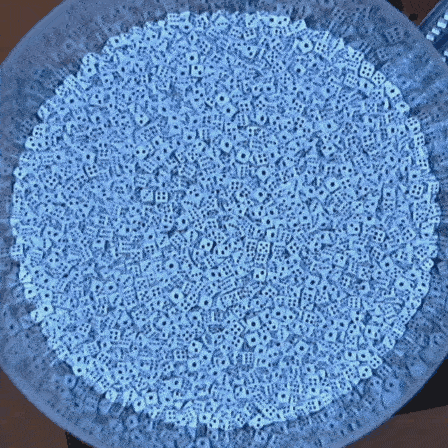
This method, known as ‘compaction dynamics,’ has a wide range of applications in industry, and scientists have long explored the best methods to pack different granular materials using gravity. Dice, it turns out, are the greatest item you can pack, though in a somewhat unique manner.
Non-spherical objects were used to test the compact dynamics. These tests have the potential to be used in space travel. It’s fascinating to see these dice organize themselves through compaction dynamics. It will transport us back to your first physics classes. On granular materials such as sand, nuts, rice, snow, coal, or coffee grains, compaction dynamics can have a fascinating effect. When it comes to granular materials, compaction dynamics go hand in hand. For instance, consider the pharmaceutical, agriculture, and energy-producing industries.
Diego Maza and collaborators from the University of Navarra in Spain explored with plastic dice in an upright cylinder exposed to oscillatory rotations along its vertical axis in order to find new ways to pack granular matter. They noticed gradual packing but also discovered that the impacts of twisting vary dramatically from those of tapping.
The team started by pouring 25,000 dice into a cylindrical container, each measuring about half a centimeter on each side. They then started turning the container, spinning it clockwise and counterclockwise at a rate of around once per second for many hundred thousand twists. The oscillation generated periodic jolts at the two points throughout each cycle where the rotation direction reversed, and the rotation imposed a force on the dice directed outward toward the walls. By varying the speed of the constant rotation between reversals, the team changed the strength of these jolts.
The findings reveal that the level of dice ordering is greatly influenced by the rotational acceleration used at each reversal. The dice achieve a final state of maximal density after around 10,000 twists for accelerations greater than half the acceleration of gravity (0.5 g). The dice are arranged horizontally within the cylinder and in symmetrically organized concentric rings within each layer in this form. For accelerations less than 0.5 g, however, the packing goes so slowly that it’s uncertain if the dice will ever obtain full density. The dice towards the core of the cylinder remains very disordered even after 100,000 twists.
According to Maza, the twisting and tapping packing processes are extremely different. A tapped granular system, even a group of cubes, will not achieve full density on its own, but will instead become trapped in an intermediate density condition. Only by a procedure termed annealing, in which the tapping becomes milder over time, can it be made denser. For powerful twisting, the dice, on the other hand, always attain the highest dense condition without annealing.
After 300,000 flips, the dice arranged themselves into neat concentric rings like a mobile bullseye. To take the research even further, the researchers experimented with various velocities and intensities, only to find that the faster the cylinder moved, the faster the dice fell into place. Naturally, moving the cylinder slowly would cause the dice to take an eternity to fall into place.
They also experimented with the twist’s strength by altering the rotation’s speed; the faster the cylinder rotated, the greater the jolt when the rotation flipped. As one might assume, the more subtle the rotation shift, the longer it takes for the dice to pack neatly. The dice scarcely moved at the lowest intensity, and the scientists estimated that reaching the densest feasible arrangement for the dice would take “10 years of twisting.”
So, when dice are twisted continuously, why do they organize themselves so cleanly? The flat surfaces on the dice will match with each other when the rotation pulls them outwards to the container’s edges under shear forces, according to the study.
They also claim that stacking cubes in this method is far more effective than tapping granular materials into place. This is because the substance will not settle into the densest potential structure until you tap in a precise way.
Nevertheless, dice seem to enjoy being twisted back and forth as long as the speed isn’t too slow. In fact, unlike the typical tapping approach, the system achieves the same ultimate state irrespective of stimulation strength (assuming it is large enough),” they write.
The team explained that Under this agitation, particle alignment is caused by the creation of shear forces among the various layers of cubes. If the excitations’ intensity is high enough, an ordered final state emerges, with the densest feasible volume fraction compatible with the boundary requirement.
Apart from being a truly amazing trick to watch in action, this dice trick could also be a launching pad toward working with materials in places where touching a container for gravity assistance isn’t a possibility, such as space. The crew is already planning research on the International Space Station to examine granular materials.
The Mexican and Spanish teams are ready to test more granular materials in the future after witnessing this fascinating phenomenon in the experiment. The researchers will complete the next research aboard the International Space Station to examine how microgravity affects granular materials, according to Physical Review Letters.
Reference:
- https://www.google.com/amp/s/amp.interestingengineering.com/scientists-capture-25000-dice-ordering-themselves-perfectly-in-a-cylinder
- https://www.sciencealert.com/packing-density-shear-force-dice-inside-cylinder-physics
- https://www.google.com/amp/s/wonderfulengineering.com/dice-ordered-themselves-in-a-cylinder/amp/
- https://www.google.com/amp/s/www.zmescience.com/science/die-cylinder-rotation-ordering-34574535/amp/















